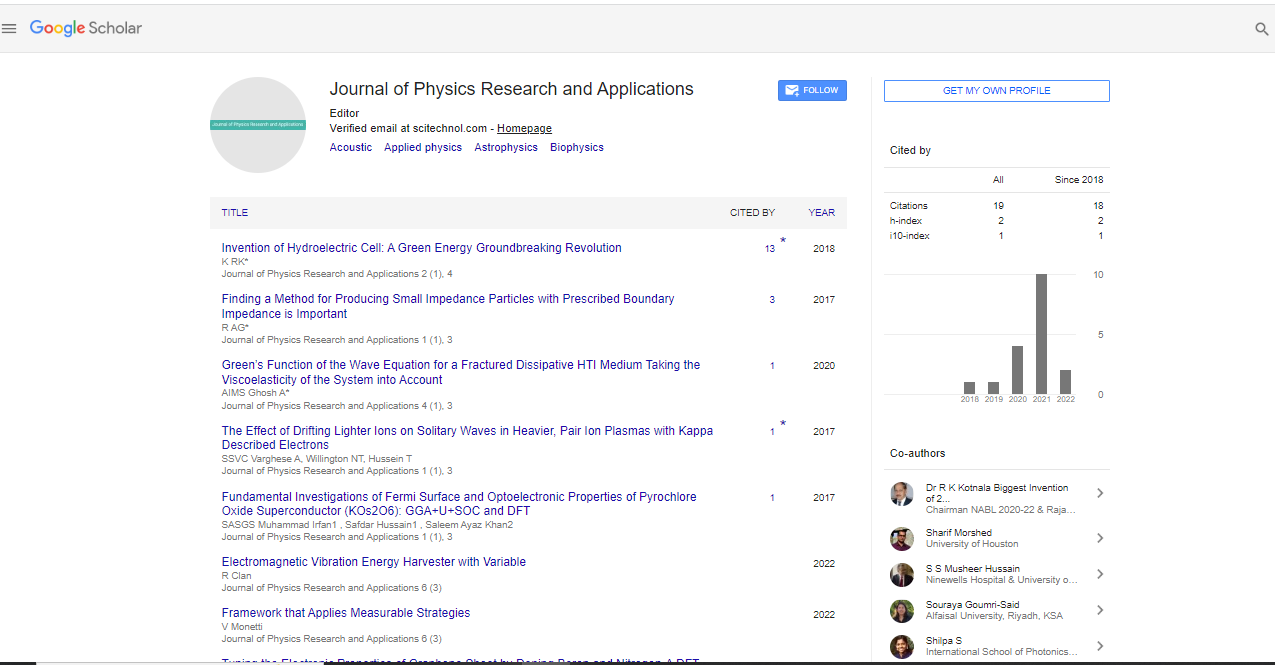Commentary, J Phys Res Appl Vol: 8 Issue: 2
Progress and Challenges in Enhancing Plasma Power by Fusion Energy
Yangfan Li*
1Department of Physics, Zhengzhou University, Zhengzhou, Henan, China
*Corresponding Author: Yangfan Li,
Department of Physics, Zhengzhou
University, Zhengzhou, Henan, China
E-mail: yang@13785.cn
Received date: 21 May, 2024, Manuscript No. JPRA-24-140076;
Editor assigned date: 23 May, 2024, PreQC No. JPRA-24-140076 (PQ);
Reviewed date: 07 June, 2024, QC No. JPRA-24-140076;
Revised date: 14 June, 2024, Manuscript No. JPRA-24-140076 (R);
Published date: 21 June, 2024 DOI: 10.4172/JPRA.1000104.
Citation: Li Y (2024) Progress and Challenges in Enhancing Plasma Power by F usion Energy. J Phys Res Appl 8:2.
Description
Fusion occurs when atomic nuclei combine to form a heavier nucleus, releasing vast amounts of energy in the process. Unlike nuclear fission, which splits atoms, fusion reactions involve isotopes of hydrogen, such as deuterium and tritium, and produce no long-lived radioactive waste. Fusion energy is virtually limitless. While significant progress has been made in fusion research, numerous challenges remain on the path to achieving practical fusion power plants. Additionally, fusion fuel sources are abundant and widely available, with deuterium extracted from water and tritium bred from lithium.
The challenge lies in creating and controlling the extreme conditions necessary for fusion to occur. Temperatures exceeding millions of degrees Celsius are required to overcome the electrostatic repulsion between atomic nuclei and bring them close enough for fusion. This state of matter, called plasma, must be confined and stabilized within a magnetic field to sustain fusion reactions. Over the past several decades, fusion research has achieved significant milestones and made substantial advancements toward realizing practical fusion power. Leading fusion experiments, such as the Joint European Torus (JET) and the International Thermonuclear Experimental Reactor (ITER), employ tokamak devices to confine and heat plasma to fusion-relevant temperatures. ITER, currently under construction in France, aims to demonstrate sustained fusion power generation and pave the way for future commercial fusion reactors.
Laser-driven fusion experiments, such as the National Ignition Facility (NIF) in the United States, use powerful lasers to compress and heat fusion fuel pellets, initiating fusion reactions. While progress has been made in achieving fusion ignition, challenges remain in achieving sustained burn and energy gain. Research into alternative fusion concepts, such as stellarators, magnetic mirror machines, and Inertial Electrostatic Confinement (IEC), offers potential paths to overcome limitations of traditional tokamak and laser-driven approaches. These diverse efforts contribute to a comprehensive understanding of plasma physics and fusion technologies. Despite the progress made, fusion research faces several technical challenges that must be addressed to realize practical fusion energy:
Maintaining stable and long-lived plasma confinement is essential for sustaining fusion reactions. Instabilities, such as plasma turbulence and disruptions, can degrade confinement and impede progress toward achieving sustained fusion burn. Fusion reactors operate under extreme conditions of heat, radiation, and particle flux. Developing materials are capable of withstanding these conditions while maintaining structural integrity and safety remains a significant challenge. Tritium, a key fusion fuel, is radioactive and poses challenges for handling, breeding, and managing its supply. Achieving a net energy gain, where fusion reactions produce more energy than consumed, is essential for the economic viability of fusion power plants. Cost-effective and efficient reactor designs are needed to compete with other energy sources.
Fusion research is inherently collaborative, with countries worldwide pooling resources and expertise to address the challenges of fusion energy. Initiatives such as ITER, an international collaboration involving 35 countries, exemplify the global effort to advance fusion research and development. With concerted efforts and advancements in plasma physics, materials science, and engineering, fusion energy has the potential to play a pivotal role in addressing global energy needs and combating climate change. As research progresses and technological barriers are overcome, fusion energy may emerge as a transformative solution for a sustainable energy future.
 Spanish
Spanish  Chinese
Chinese  Russian
Russian  German
German  French
French  Japanese
Japanese  Portuguese
Portuguese  Hindi
Hindi 
